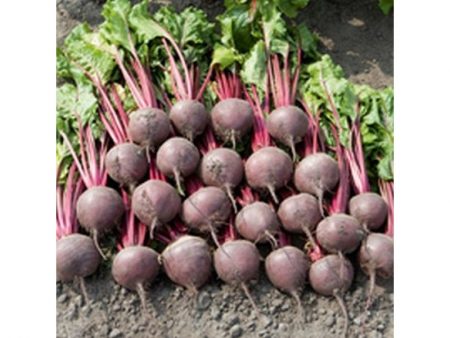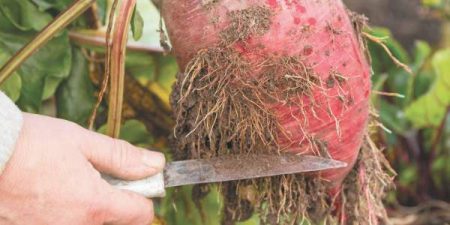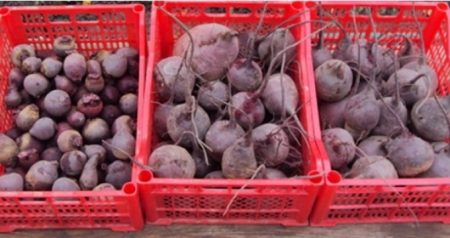- Agricultural practices that increase the shelf life of root crops.
- When to dig beets from the beds.
- Harvesting beets and preparing root crops for storage.
- Storage features.
Beetroot is a very unpretentious crop. It is quite easy to grow it, following the simplest agricultural techniques. The timing of beet harvesting depends on the growing season and planting time.
Agricultural practices that increase the quality and keeping quality of beets
The keeping quality of beets largely depends on the growing conditions. The culture loves fertile, light soil. If it grows on clay soil, then the soil should be loose and well dug. If the soil density is too high, the vegetable may not set.
The culture grows well on slightly acidic and neutral soils (pH 5.5-7). If the reaction is more acidic, then the root vegetables are small, fibrous, contain little sugar, and become tough during storage. Beets tolerate lime well, so if you need to quickly shift the pH, add fluff in the fall. Dolomite and limestone flour are not suitable for these purposes because they deoxidize the soil too slowly. They can be added if the crop will be in the garden in 2-3 years.
If during cultivation the tops of the vegetable turn red (a sign of acidic soil), then fertilize with milk of lime. You can apply lime deposits left over from fertilizing other crops with milk, covering it to a depth of 4-6 cm.
Fresh and even half-rotted manure cannot be added to the crop, because, at best, the root crops will not set, and at worst, they will rot.
At an early age, beets do not tolerate frost well. When the temperature drops to +4°C, it will bloom and will not set root crops. Therefore, at low temperatures, seedlings are covered with straw, sawdust, etc. The same can happen at temperatures above +27-30°C during the initial growth period (although this happens very rarely). In this case, the seedlings are watered abundantly.
During the initial period of growth, the vegetable needs moisture. In dry weather, it is watered 1-2 times a week, depending on the temperature. But as soon as the root crops set, watering is stopped, since the plant has a very long main root, which extracts water from great depths.Excessive soil moisture leads to plant rotting.
Several sprouts can appear from one beet seed. At the age of 2-3 true leaves, the plants are thinned out, removing excess ones and leaving a distance of 12-15 cm between them. To obtain not too large products, the seedlings are planted compactly according to a 7x10 cm pattern.
In the northern regions, in order to quickly obtain high-quality root crops during transplantation, the main root is cut off by 1/3. In the south, this is not recommended, since in the absence of moisture and drought, the root crops will be small and fibrous.
Beet food
- To obtain high-quality root crops with good taste and shelf life, plants are fed every 20-25 days. Most of all, the crop needs potassium, and it is also resistant to chlorine, so you can feed it with any potassium fertilizer, including those containing chlorine.
- To increase the sugar content, the vegetable is watered with a solution of table salt (2 tablespoons per 10 liters of water) 2 times per season.
- The culture needs microelements, especially boron. After setting root crops, it is fed 2 times with any microfertilizer containing boron. In the absence of this element, the beets turn out hollow and are poorly stored.
- There is no need to feed beets with nitrogen, since they accumulate it in the produce in the form of nitrates. Such root vegetables are easily recognized by the white concentric circles on the cut. It is better not to use them, otherwise you may get poisoned.
When these simple rules are followed, a vegetable with excellent marketability and taste is obtained.
When to dig beets from the beds
The time for harvesting beets for storage depends on the variety.
- Early varieties (Boyarynya, Pomegranate juice, Kuban borscht) grow for 50-80 days and are dug up by the end of July.They are stored somewhat worse than mid-season varieties. They are used for 2-3 months.
- Mid-season varieties. Ripening time is 80-100 days. Harvest from the beds from mid-August to mid-September. Root crops store well, but by spring they begin to sprout. Mid-season varieties include Bordeaux, Krasny Bogatyr, Rocket, and Cylinder.
- Late varieties (Commander, Matrona, Ethiopian) have been dug up for storage since mid-September. They are well stored until the new harvest, without losing their taste and commercial qualities. The ripening period is more than 100 days.
Signs that root crops are ready for harvesting are yellowing and drying of the lower leaves.
It is undesirable to dig up root crops either too early or too late. There is no need to dig up beets early, since the tops will not have time to release all the nutrients; in the future, the unripe crop will be stored worse. In the fall, intensive filling of root crops occurs; it is at this time that the greatest amount of nutrients accumulates in them.
When harvesting is delayed, the beets begin to cork, white stripes appear on the root crops, and they sprout. Autumn frosts can damage the crop and make it unsuitable for storage, so if there is a threat of frost, beets are immediately harvested, regardless of their ripeness. It’s better to get at least something than to be left without a harvest at all.
When harvesting middle and, especially, late varieties, you should be guided by the weather.
- If autumn is dry and cool - this is the best time for culture. In such weather, you can not rush to dig up beets, but leave them in the ground longer, they will accumulate a lot of useful substances.
- At rainy autumn Root vegetables accumulate a lot of moisture, which leads to loss of taste and cracking. If the crop is not dug up from the beds for a long time, it will rot.
- IN warm autumn the crop germinates, and if it does not have time to germinate, it will become tough and fibrous. In such weather, as soon as signs of readiness of root crops appear, they are dug up.
No matter the weather, you cannot leave a vegetable in the ground for a long time; it will either germinate or rot. If it is not known exactly what variety is growing, then as soon as signs of ripening become clear enough, the crop is dug up.
Harvesting beets and preparing the crop for storage
The most suitable conditions for harvesting beets for storage are dry, cold, cloudy weather with an air temperature of at least 4°C. In loose soil, if the beets protrude strongly from the ground, you can simply pull them by the tops. If the soil is dense, then the crop is dug up by prying it up with a shovel or pitchfork, and then picking it out of the ground. The digging depth is at least 4-5 cm, otherwise the beets can be injured. When digging deeply, only the main root is injured, which does not affect storage in any way.
The dug up root crops are left in the garden for 3-4 hours to dry. There is no need to leave it longer than this time, as the beets begin to lose moisture. If the vegetable was dug up in wet weather, then dry it under a canopy, laying it out in one layer. Drying time is 2-3 days.
After drying, cut off the tops. If the beets are dried in the open air, then the tops are removed at the end, if in a barn - the next day. In most varieties, the leaves are cut off with a knife, leaving a tail of no more than 1 cm. With lower pruning, the apical bud is injured and the crop rots.But some varieties allow the above-ground part to be simply twisted, without damaging the root crop, and the tails remain just the right length. Then the dug vegetables are cleared of soil and the side roots are cut off. The main root is also cut off, leaving a tail of 4-5 cm.
Root crops are sorted by size. The largest ones are coarser, more fibrous and take longer to cook, and they also store worse. Small ones, on the contrary, have less fiber, have good keeping quality and cook quickly. Therefore, when sorting, small ones are placed at the bottom of the box, and large ones are left at the top. Beets damaged by pests or during digging, as well as those that have an ugly shape or have lost their presentation, are not removed for storage, but used immediately. Such vegetables will not be stored anyway.
Storage Features
Sorted vegetables are stored. Root crops, especially late varieties, can be stored in various conditions: in piles in the open air, in the cellar, boxes, nets, bags, in bulk in insulated sheds, refrigerators.
Basic storage requirements:
- temperature 1-4°C;
- humidity 90-95%;
- sufficient air circulation.
Beets are well stored in cellars with sufficient ventilation, on insulated balconies, if the temperature there does not rise above 5°C (otherwise it will germinate). Beets do not store very well in the refrigerator, since there is no constant air flow. Once every 10-14 days, it is taken out of the refrigerator for 15-24 hours to ventilate.
In places with poor ventilation, where there is no flow of fresh air, root crops rot. At temperatures above 4°C, vegetables lose moisture, become flabby, and germinate early in the spring. If there is insufficient moisture, beets shrivel and become fibrous.
But, compared to other root vegetables, beets are quite easy to grow and preserve.
Digging up beets for winter storage








 CUCUMBERS NEVER GET SICK, I'VE BEEN USING ONLY THIS FOR 40 YEARS! I SHARE A SECRET WITH YOU, CUCUMBERS ARE LIKE THE PICTURE!
CUCUMBERS NEVER GET SICK, I'VE BEEN USING ONLY THIS FOR 40 YEARS! I SHARE A SECRET WITH YOU, CUCUMBERS ARE LIKE THE PICTURE! You can dig a bucket of potatoes from each bush. Do you think these are fairy tales? Watch the video
You can dig a bucket of potatoes from each bush. Do you think these are fairy tales? Watch the video
 How our fellow gardeners work in Korea. There is a lot to learn and just fun to watch.
How our fellow gardeners work in Korea. There is a lot to learn and just fun to watch. Eye trainer. The author claims that with daily viewing, vision is restored. They don't charge money for views.
Eye trainer. The author claims that with daily viewing, vision is restored. They don't charge money for views. A 3-ingredient cake recipe in 30 minutes is better than Napoleon. Simple and very tasty.
A 3-ingredient cake recipe in 30 minutes is better than Napoleon. Simple and very tasty. Therapeutic exercises for cervical osteochondrosis. A complete set of exercises.
Therapeutic exercises for cervical osteochondrosis. A complete set of exercises. Which indoor plants match your zodiac sign?
Which indoor plants match your zodiac sign? What about them? Excursion to German dachas.
What about them? Excursion to German dachas.